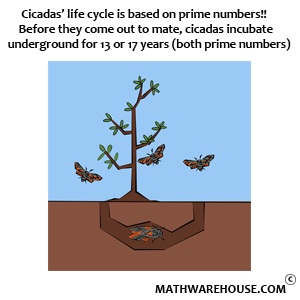Quick Overview
- Exponent forms that are indeterminate: $$ 0^0 $$, $$ 1^\infty $$, and $$ \infty^0 $$.
- Interestingly, the $$ 0^\infty $$ form is NOT an indeterminate form.
- The original functions will have the form: $$ y = u^v $$ where $$ u $$ and $$ v $$ are functions of $$ x $$.
- The basic adjustment that that we make is $$ y = e^{\ln(u^v)} $$ which simplifies to $$ y = e^{v\cdot \ln u} $$.
- Be sure you understand the previous lesson: L'Hôpital's Rule: The $$ 0\cdot \infty $$ Forms
- The number $$ e $$ is often defined with this type of limit.
Indeterminate Forms Involving Exponents
Consider each of the limits shown below.
$$ \displaystyle\lim_{x\to 0^+} x^x = 0^0 \qquad \displaystyle\lim_{x\to\infty} \left(\ln x\right)^{1/x} = \infty^0 \qquad \displaystyle\lim_{x\to \infty} \left(1+\frac 1 x\right)^x = 1^\infty $$
Each of these limits results in an indeterminate expression that can be handled with L'Hôpital's rule if we first change the form of the function.
Basic Approach
Recall that
$$ e^{% \ln(% u ) } = u. $$
We typically think of this equation as a way to simplify exponentials and logarithms. However,for the limits we'll be examining, we use the equation in "reverse".
Example 1
Rewrite $$ f(x) = x^{\sin x} $$ using the equation described above and simplify using the properties of logarithms.
Step 1Apply the exponential and natural log.
$$ f(x) = \blue{% x^{\sin x} } % = e^{% \ln\left(% \blue{% x^{\sin x} } \right) } $$
Step 2Simplify the exponent using the properties of logarithms.
$$ f(x) = e^{% \ln\left(% x^{% \blue{\sin x} } \right) } % = e^{% \blue{\sin x} \cdot \ln x } $$
Answer$$\displaystyle f(x) = e^{\sin x\cdot \ln x}$$
Evaluating the Revised Limit
After rewriting the function, only the exponent is affected by the value of the variable. So, we narrow our focus to the exponent (this makes the notation easier to read).
Example 2
Evaluate $$\displaystyle\lim_{x\to 0^+} x^{\sin x}$$ (This is the function from Example 1).
Step 1Evaluate the limit in its current form.
$$ \displaystyle\lim_{% \blue{% x\to 0^+ } } = \blue x^{% \sin \blue x } % = \blue 0^{% \sin \blue 0 } % = 0^0 $$
This is an indeterminate form involving exponents, so we will need to rewrite the function using the idea from Example 1.
Step 2Rewrite the function as in Example 1, then pass the limit notation into the exponent.
$$ \begin{align*}\lim_{x\to 0^+} x^{% \sin x } % & = \lim_{x\to 0^+} e^{% \sin x\cdot \ln x } && \text{Rewritten as in Example 1} \\[6pt] % & = e^{% \lim_{x\to 0^+} \sin x\cdot \ln x } && \text{Pass the limit into the exponent.} \end{align*} $$
Note: When there isn't a whole lot of vertical space (like in an exponent), we often write the "$$x \to a$$" in a limit off to the side instead of underneath the "$$\lim$$".
$$ \textstyle \lim_{x\to a} f(x) = \displaystyle \lim_{x\to a} f(x) $$
Step 3Narrow the focus to just the exponent and evaluate the limit.
$$ \displaystyle\lim_{x\to 0^+} \blue{\sin x}\cdot \red{% \ln x } % = \blue 0\, \red{% (-\infty) } $$
This is the indeterminate form we studied in the previous lesson.
Step 4Rewrite the limit in the $$ \frac \infty \infty $$ form.
$$ \displaystyle\lim_{x\to 0^+} \blue{\sin x} \cdot \ln x % = \displaystyle\lim_{x\to 0^+} \frac{% \ln x } {% \blue{1/\sin x} } % = \displaystyle\lim_{x\to 0^+} \frac{% \ln x } {% \blue{\csc x} } % = \frac \infty \infty $$
Step 5Use L'Hôpital's rule and re-evaluate the limit.
$$ \begin{align*} \lim_{x\to 0^+} \frac{% \ln x } {\csc x} % & = \lim_{x\to 0^+} \frac{% \red{% \frac d {dx} \left(% \ln x \right) } } {% \blue{% \frac d {dx} \left(% \csc x \right) } } \\[6pt] % & = \lim_{x\to 0^+} \frac{% \red{1/x} } {% \blue{% -\csc x \cot x } } \\[6pt] % & = \lim_{x\to 0^+} \red{% \frac 1 x } \cdot \blue{% \frac 1 {\csc x} \cdot \frac 1 {\cot x} } \\[6pt] % & = \lim_{x\to 0^+} \red{% \frac 1 x } \cdot \blue{% \frac{\sin x} 1 \cdot \tan x } \\[6pt] % & = \lim_{x\to 0^+} \frac{\sin x} x \cdot \tan x \\[6pt] % & = \lim_{x\to 0^+} 1 \cdot 0 \\[6pt] % & = 0 \end{align*} $$
Note that, in earlier lessons, we showed $$ \lim\limits_{x\to0} \frac{\sin x} x = 1 $$ You could also use L'Hôpital's rule to evaluate it.
Step 6Evaluate the original limit using the values we've found.
Recall that in Step 2 we rewrote the limit using the exponential and natural log functions. Then in Step 3 we narrowed our focus to just the exponent. Now we need to expand our focus back to the entire problem.
$$ \begin{align*} \lim_{x\to0^+} \left(% \sin x \right)^x % & = e^{% \blue{% \lim_{x\to 0^+} x\, \ln(\sin x) } } && \text{ from Step 2 } \\[6pt] % & = e^{\blue 0} && \text{ from Step 3 } \\[6pt] % & = 1 \end{align*} $$
Answer$$ \displaystyle \lim_{x\to0^+} \left(% \sin x \right)^x = 1 $$
For reference, here is the graph of the function and the limit value.

A Definition of the Number $$e$$
The number $$ e $$ that is used as the base of natural exponential and logarithmic functions is often defined using the following limit:
$$ \displaystyle\lim_{x \to \infty} \left(% 1 + \frac 1 x \right)^x. $$
(As side note, there are other ways to define the number $$ e $$, some of which we will see in later lessons). Let's get some practice by evaluating this limit.
Example 3
Evaluate $$ \displaystyle \lim_{x \to \infty} \left(% 1 + \frac 1 x \right)^x$$.
Step 1Evaluate the limit in its current form.
$$ \displaystyle\lim_{x \to \infty} \left(% 1 + \frac 1 {% \blue x } \right)^x % = \left(% 1 + \frac 1 {% \blue \infty } \right)^\infty % = \left(% 1 + \blue 0 \right)^\infty % = 1^\infty $$
Step 2Rewrite the limit using the exponential and natural log functions, and pass the limit into the exponent of $$ e $$.
$$ \displaystyle\lim_{x \to \infty} \blue{% \left(% 1 + \frac 1 x \right)^x } % = \displaystyle\lim_{x \to \infty} e^{% \ln \blue{% \left(% 1 + \frac 1 x \right)^x } } % = e^{% \lim_{x \to \infty} \ln \left(% 1 + \frac 1 x \right)^x } $$
Step 3Next we narrow our focus to just the exponent of $$ e $$. We'll simplify using the properties of logarithms and re-evaluate the limit.
$$ \begin{align*} \lim_{x \to \infty} \red{% \ln \left(% 1 + \frac 1 x \right) }^{% \blue x } % & = \lim_{x \to \infty} \blue x\, \red{% \ln \left(% 1 + \frac 1 x \right) } && \text{Property of Logarithms} \\[6pt] % & = \blue \infty \cdot\red{% \ln 1 } && \text{Evaluating} \\[6pt] % & = \blue \infty \cdot\red 0 \end{align*} $$
Step 4Rewrite the limit so it has the $$ \frac 0 0 $$ form.
$$ \displaystyle\lim_{x \to \infty} \blue x\, \red{% \ln \left(% 1 + \frac 1 x \right) } % = \displaystyle\lim_{x \to \infty} \frac{% \red{% \ln \left(% 1 + \frac 1 x \right) } } {% \blue{1/x} } = \frac{% \red{% \ln 1 } } {% \blue{% 1/\infty } } % = \frac{% \red 0 } {% \blue 0 } $$
Step 5Apply L'Hôpital's rule and re-evaluate the limit.
$$ \begin{align*} \lim_{x \to \infty} \frac{% \ln \left(% 1 + \frac 1 x \right) } { 1/x } % & = \lim_{x \to \infty} \frac{% \red{% \frac d {dx} \left[% \ln \left(% 1 + x^{-1} \right) \right] } } {% \blue{% \frac d {dx} \left( x^{-1} \right) } } \\[6pt] % & = \lim_{x \to \infty} \frac{% \red{% \frac 1 {% 1 + x^{-1} } \cdot\left(% -x^{-2} \right) } } {% \blue{% -x^{-2} } } \\[6pt] % & = \lim_{x \to \infty} \frac{% \frac 1 {% 1 + x^{-1} } \cdot\cancelred{% \left(% -x^{-2} \right) } } {% \cancelred{% \left(% -x^{-2} \right) } } \\[6pt] % & = \lim_{x \to \infty} \frac 1 {% 1 + x^{-1} } \\[6pt] % & = \lim_{x \to \infty} \frac 1 {% 1 + \frac 1 x } \\[6pt] % & = \frac 1 {1 + 0} \\[6pt] % & = 1 \end{align*} $$
Step 6Evaluate the original limit.
$$ \begin{align*} \lim_{x \to \infty} \left(% 1 + \frac 1 x \right)^x % & = e^{% \blue{% \lim_{x \to \infty} \ln \left(% 1 + \frac 1 x \right)^x } } && \text{ from Step 2 } \\[6pt] % & = e^{\blue 1} && \text{ from Step 5 } \\[6pt] % & = e \end{align*} $$
Answer$$ \displaystyle \lim_{x \to \infty} \left(% 1 + \frac 1 x \right)^x = e $$.
DON'T HAVE A Knee-Jerk Reaction!
Sometimes a limit question will look like it is an indeterminate form, but in reality it just needs a little simplifying. Consider the next example.
Example 4
Evaluate $$ \displaystyle \lim_{x\to\infty} \left(% e^x \right)^{% 1/x^2 }$$.
Step 1Evaluate the limit in its current form.
$$ \displaystyle\lim_{x\to\infty} \left(% e^x \right)^{% 1/x^2 } % = \left(% e^\infty \right)^{% 1/\infty } % = \infty^0 $$
which is certainly one of the indeterminate forms we're talking about in this lesson. However, let's do a little simplifying before rushing headlong into the L'Hôpital's Rule approach.
Step 2Simplify the function using properties of exponents.
$$ \begin{align*} \lim_{x\to\infty} \left(% e^{\blue x} \right)^{% \red{1/x^2} } % & = \lim_{x\to\infty} e^{% \blue x \cdot \red{% x^{-2} } } && \text{Recall: } (a^m)^n = a^{mn} \\[6pt] % & = \lim_{x\to\infty} e^{% x^{-1} } \\[6pt] % & = \lim_{x\to\infty} e^{% 1/ \blue x } \\[6pt] % & = e^{% 1/ \blue\infty } && \text{Evaluating the limit} \\[6pt] % & = e^0 \\[6pt] % & = 1 \end{align*} $$
See? No L'Hôpital's rule necessary!
Answer$$ \displaystyle \lim_{x\to\infty} \left(% e^x \right)^{% 1/x^2 } = 1 $$.
Why Isn't the $$ 0^\infty $$ Form Indeterminate?
We'll use the same technique that we've been using for the previous examples to explain why the $$ 0^\infty $$ form is not indeterminate.
Example 5
Suppose $$ \lim_{x\to a} f(x) = 0^\infty$$ . Show that the limit is not indeterminate.
Step 1Let's define two functions where all we know about them is their limits:
$$ \begin{align*} \text{Define } u(x) \text{ so that } \lim_{x\to a} & u = 0 \\[6pt] % \text{Define } v(x) \text{ so that } \lim_{x\to a} & v = \infty \\[6pt] % \end{align*} $$
where $$ a $$ is any number, OR $$ \infty $$.
Notice that, according to our definitions
$$ \displaystyle\lim_{x\to a} \blue u^{ \red{v} } % = \blue 0^{% \red \infty }. $$
So that $$ f(x) = u^v $$.
Step 2As in previous examples, use the exponential and natural log functions to rewrite the limit and move it into the exponent.
$$ \displaystyle\lim_{x\to a} \blue{% u^v } % = \lim_{x\to a} e^{% \ln\left(% \blue{% u^v } \right) } % = e^{% \lim_{x\to a} v\cdot \ln u } $$
Step 3Now, evaluate the limit in the exponent.
$$ \begin{align*}% \lim_{x\to a} u \cdot \ln v % & = \lim_{x\to a} \blue u \cdot \ln \red v % = \lim_{x\to a} \blue \infty \cdot \ln \red 0 % = \lim_{x\to a} \blue \infty \cdot \red{% (-\infty) } % = -\infty \end{align*} $$
This means the original limit is
$$ \displaystyle\lim_{x\to a} u^v % = e^{% \lim_{x\to a} v\cdot \ln u } % = e^{-\infty} % = 0 $$
AnswerIf $$ \displaystyle \lim_{x\to} u^v = 0^\infty $$, the end result will always equal $$ 0 $$.
Interestingly, limits that have the form $$ 0^{-\infty} $$ have a somewhat different result (though still NOT indeterminate). In the questions at the end of the lesson, we'll work through this variation.




















